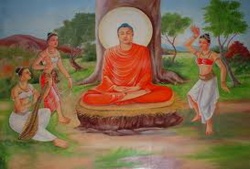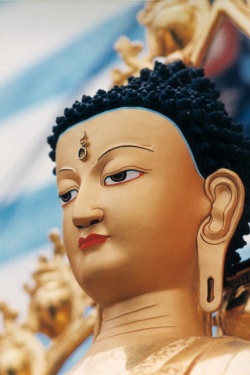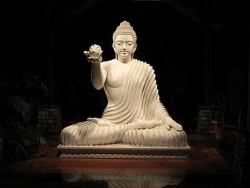Sixth consciousness
Sixth Consciousness
Below, the first four lines discuss the range of the sixth consciousness; the second four discuss its role in the creation of karma and in the resultant karmic activity. The final four explain its transformation into wisdom.
Having Three Natures and with Three Modes of Knowledge, it pervades the Three States.
The Three Natures are the wholesome, the unwholesome, and the indeterminate.
The Three Modes of Knowledge are direct perception, inference and fallacy.
The Three States are the natural state, the state of solitary impressions, and the state of transposed substance. They have already been explained above (see Part One, line one).
The sixth consciousness uses all three modes of knowledge in its awareness of the three states. The Three Natures refers to classification of the moral nature of its activity. The distinction-making of the sixth consciousness is considered to be of a wholesome nature if it is beneficial. Such activity arises karmically as a result of good roots, that is, it is the fruition of the seeds planted by wholesome activity in the past. The situation is the opposite for distinction-making of an unwholesome nature. Indeterminate distinction-making is neither beneficial nor non-beneficial and arises from past activity that was correspondingly so.
The last type, the indeterminate nature, is divided into the obscuring indeterminate nature and the non-obscuring indeterminate nature; they will be explained below in the section on the seventh consciousness.
As it turns on the wheel, it easily comes to know the Three Realms it turns within.
The Three Realms are the realm of desire, the realm of form, and the formless realm.
What causes our revolving within the Three Realms on the wheel of the Six Destinies are the distinctions made in the sixth consciousness. The distinctions lead to karmic activity and then to karmic retribution. Because of its great power of making distinctions, the sixth consciousness easily distinguishes and classifies the different states--environments--of the realms with which it comes into contact.
It interacts with all fifty-one Dharmas Interactive with the Mind.
The sixth consciousness interacts with all fifty-one of the Dharmas Interactive with the Mind. The fifty-one are listed in the appendix on the One Hundred Dharmas and are described in the Shastra on the Door to Understanding the Hundred Dharmas.
Whenever it is wholesome or unwholesome, they make distinctions and accompany it.
When the activity of the sixth consciousness is wholesome, it is accompanied by the Eleven Wholesome Dharmas of the One Hundred Dharmas. When its activity is unwholesome, the dharmas of affliction arise in conjunction with it.
Its Three Natures, the Three States it relates with, and its Three Kinds of Feeling are constantly in flux.
In other words the moral classification, and so forth, of the sixth consciousness changes from moment to moment. The sixth consciousness is involved in a constant flux of distinction-making. In the case of the Three Natures, wholesome, unwholesome, and indeterminate indicate the moral categories od its activity; in the case of the Three States--the natural, and those of solitary impressions and of transposed substance--the categories indicate degrees of reality; and in
the case of the Three Kinds of Feeling, the distinctions of pleasure, of pain, and of neutral feelings classify the emotional and perceptual experiences we undergo on their most fundamental level of reception. One difference between the Three Natures and the Three Kinds of Feeling is that the former is an analysis of causal activity and the latter is an analysis of experiential effect.
The basic and subsidiary afflictions together with faith and other wholesome dharmas always arise jointly with the sixth consciousness.
The afflictions and wholesome dharmas are all dependent upon the sixth consciousness. In other words they are not really separate from it but represent further categorization of distinctions within it. However, as explained above, depending on the nature of the sixth consciousness at any particular moment, the afflictions and the wholesome dharmas do not necessarily all arise together, that is, at the same time.
In physical action and in speech it is the most important.
In the creation of karma the volitional activity of the sixth consciousness plays the most important role. Examination and decision, which are both functions of the sixth consciousness, lead to activity, which creates both speech and bodily karma.
It brings to completion by its ability to summon forth the power of karma that leads [to rebirth).
This line further explains the karma-generating power of the sixth consciousness. It brings about karmic activity that leads to retribution, which is the completion of the three-stage karmic process:
1) giving rise to delusion,
2) creating karma, and
3) undergoing retribution. When karma is created,
seeds are planted in the eighth consciousness. At the time of rebirth it is the ripening of those seeds, "the power of karma", that draws the eighth consciousness back into the suffering of the Six Paths of Rebirth.
When the state of mind that is the initial phase of the Ground of Rejoicing arises,
The Ground of Rejoicing is the first of the Ten Grounds of the Bodhisattva's Path. Each of the ten is divided into the initial (or entering), dwelling, and departing phases.
Innate attachments still spontaneously appear as bonds and latent tendencies.
The two major kinds of attachment, to self and to dharmas, are further divided into two types: innate and distinguished. Innate are present at birth, and distinguished are learned subsequently. At this point, when the sixth consciousness begins to be transformed into the Wisdom of Wonderful Contemplation, the distinguished attachments have already been eliminated. The
distinguished belong to the sixth consciousness, while the innate ones are found in both sixth and seventh. The innate are slowly eradicated up through the tenth ground. The latent tendencies refer to the seeds of the affliction-obstacle and of the obstacle of the knowable. Therefore, the line indicates that even at the point of entrance onto the First Ground innate attachments still exist in the sixth consciousness, both as manifest "bonds" and as latent potentials or "seeds".
After the Far-reaching Ground, it is purified and without outflows.
The Far-reaching Ground is the seventh ground of the Bodhisattva. At the eighth ground, called the Unmoving Ground, one is without outflows. The sixth consciousness's attachment to the perceiver-division of the eighth, storehouse, consciousness as being the Self is abandoned, so there is no longer any attachment to self, only to dharmas.
How the seventh consciousness becomes attached to the perceiver division of the eighth consciousness as the self is explained in the initial section on the seventh consciousness.
When the Wisdom of Wonderful Contemplation becomes fully bright, it illuminates the universe.
At Buddhahood the transformation of consciousness into wisdom is completed, and the light of the Wisdom of Wonderful Contemplation illuminates everywhere.


